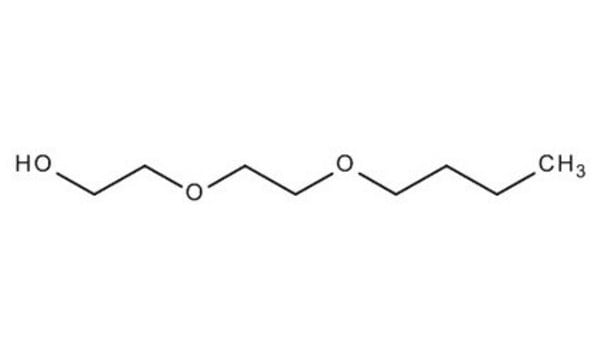03351
Diethylene glycol monobutyl ether
for surfactant analysis, ≥99.0%
Sinônimo(s):
2-(2-Butoxyethoxy)ethanol, BDG, Butyldiglycol
About This Item
Produtos recomendados
grau
for surfactant analysis
Nível de qualidade
Ensaio
≥99.0% (GC)
≥99.0%
forma
liquid
Impurezas
≤0.1% water
índice de refração
n20/D 1.432
pb
224-228 °C (lit.)
densidade
0.953 g/mL at 20 °C (lit.)
cadeia de caracteres SMILES
CCCCOCCOCCO
InChI
1S/C8H18O3/c1-2-3-5-10-7-8-11-6-4-9/h9H,2-8H2,1H3
chave InChI
OAYXUHPQHDHDDZ-UHFFFAOYSA-N
Procurando produtos similares? Visita Guia de comparação de produtos
Aplicação
- Optimal Design of Alkaline-Surfactant-Polymer Flooding under Low Salinity Environment: Research highlights the use of diethylene glycol monobutyl ether in enhancing the efficiency of enhanced oil recovery methods, particularly in low salinity environments. This application points to its potential in reducing the environmental footprint of oil extraction processes (Novriansyah A, et al., 2020).
- Bioaugmentation for treatment of full-scale diethylene glycol monobutyl ether (DGBE) wastewater by Serratia sp. BDG-2: Demonstrates the solvents biodegradability and the potential for its removal from wastewater using specific bacterial strains, highlighting important environmental safety considerations (Chen M, et al., 2016).
- Diethylene glycol mono butyl ether concentrations in room air from application of cleaner formulations to hard surfaces: Examines the air quality implications of using diethylene glycol monobutyl ether in cleaning products, stressing the importance of monitoring and managing indoor air pollutants in industrial and domestic environments (Gibson WB, et al., 1991).
Palavra indicadora
Warning
Frases de perigo
Declarações de precaução
Classificações de perigo
Eye Irrit. 2
Código de classe de armazenamento
10 - Combustible liquids
Classe de risco de água (WGK)
WGK 1
Ponto de fulgor (°F)
210.2 °F - closed cup
Ponto de fulgor (°C)
99 °C - closed cup
Equipamento de proteção individual
Eyeshields, Gloves, type ABEK (EN14387) respirator filter
Choose from one of the most recent versions:
Já possui este produto?
Encontre a documentação dos produtos que você adquiriu recentemente na biblioteca de documentos.
Os clientes também visualizaram
Nossa equipe de cientistas tem experiência em todas as áreas de pesquisa, incluindo Life Sciences, ciência de materiais, síntese química, cromatografia, química analítica e muitas outras.
Entre em contato com a assistência técnica














